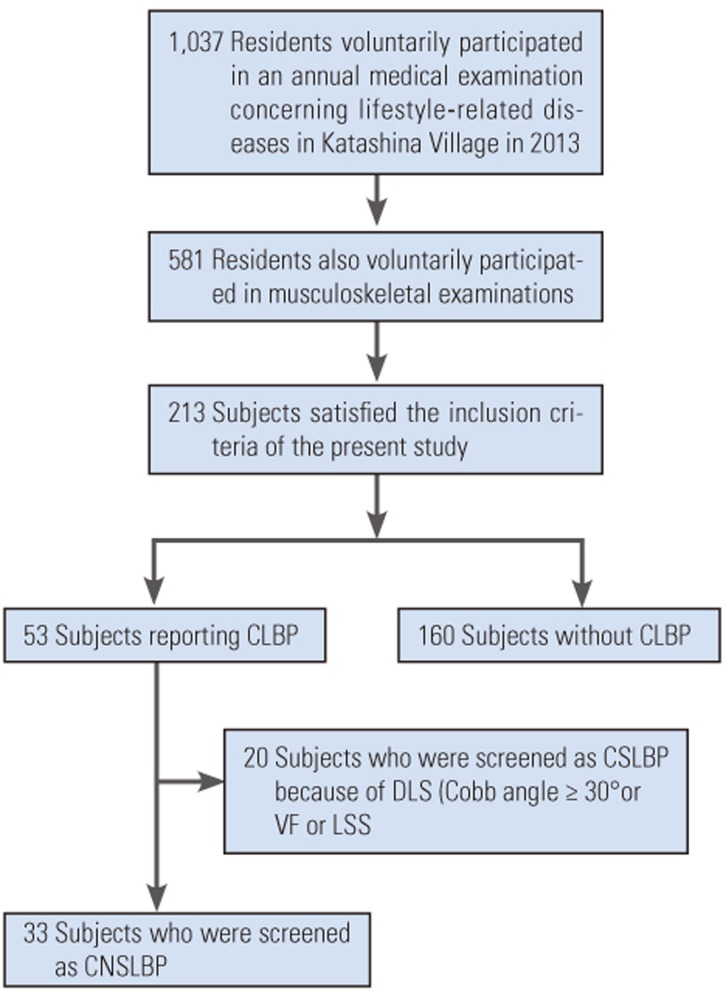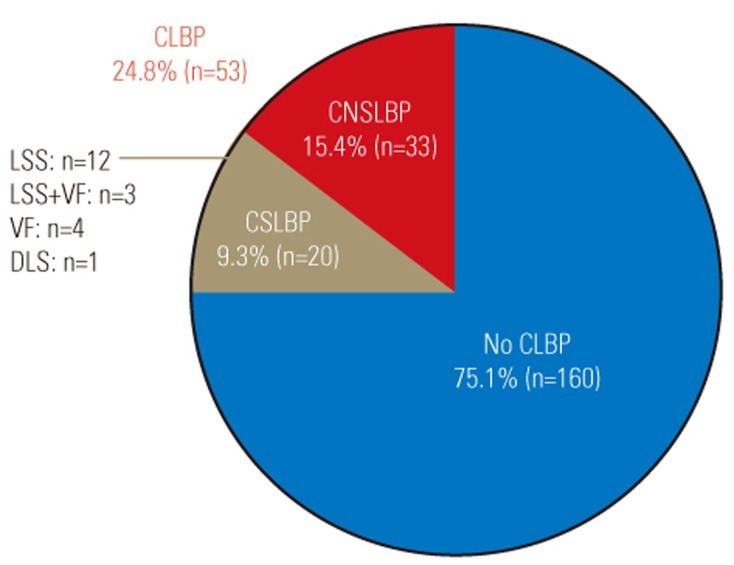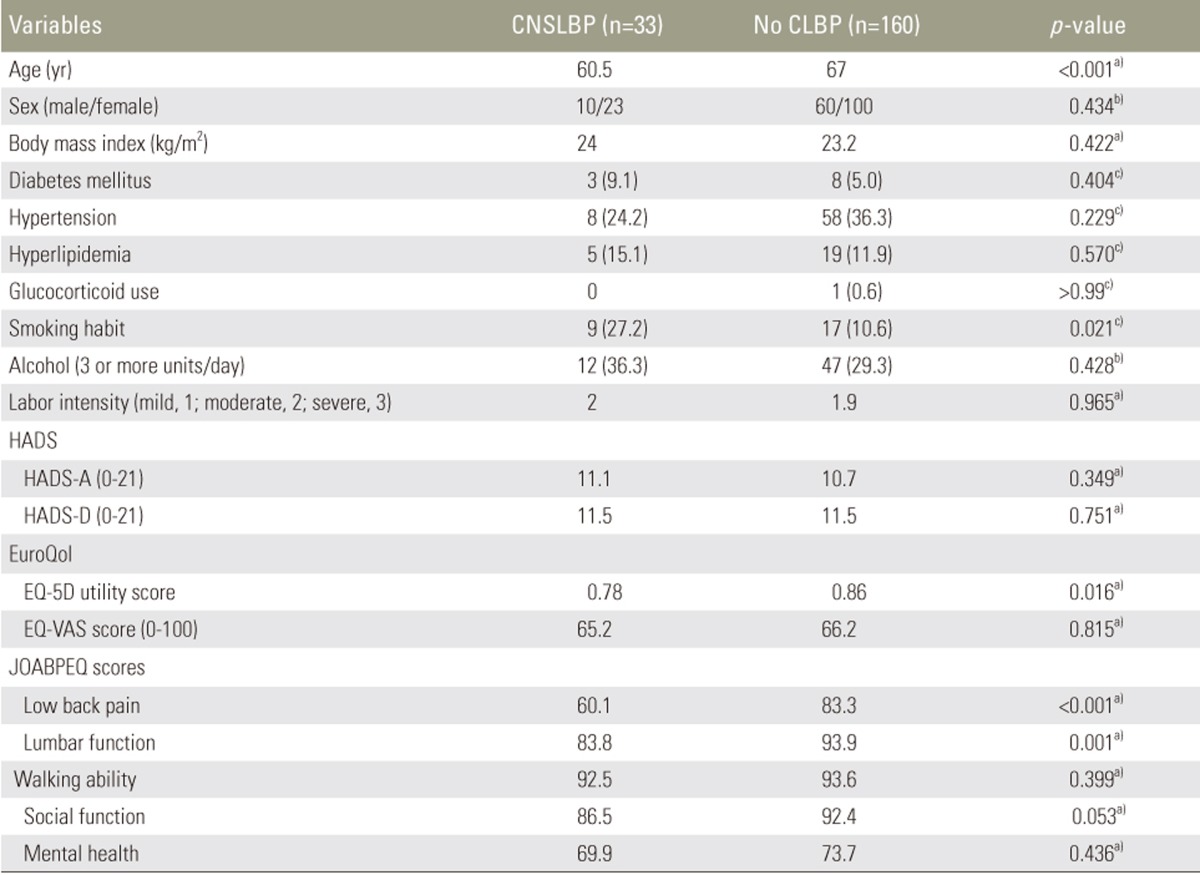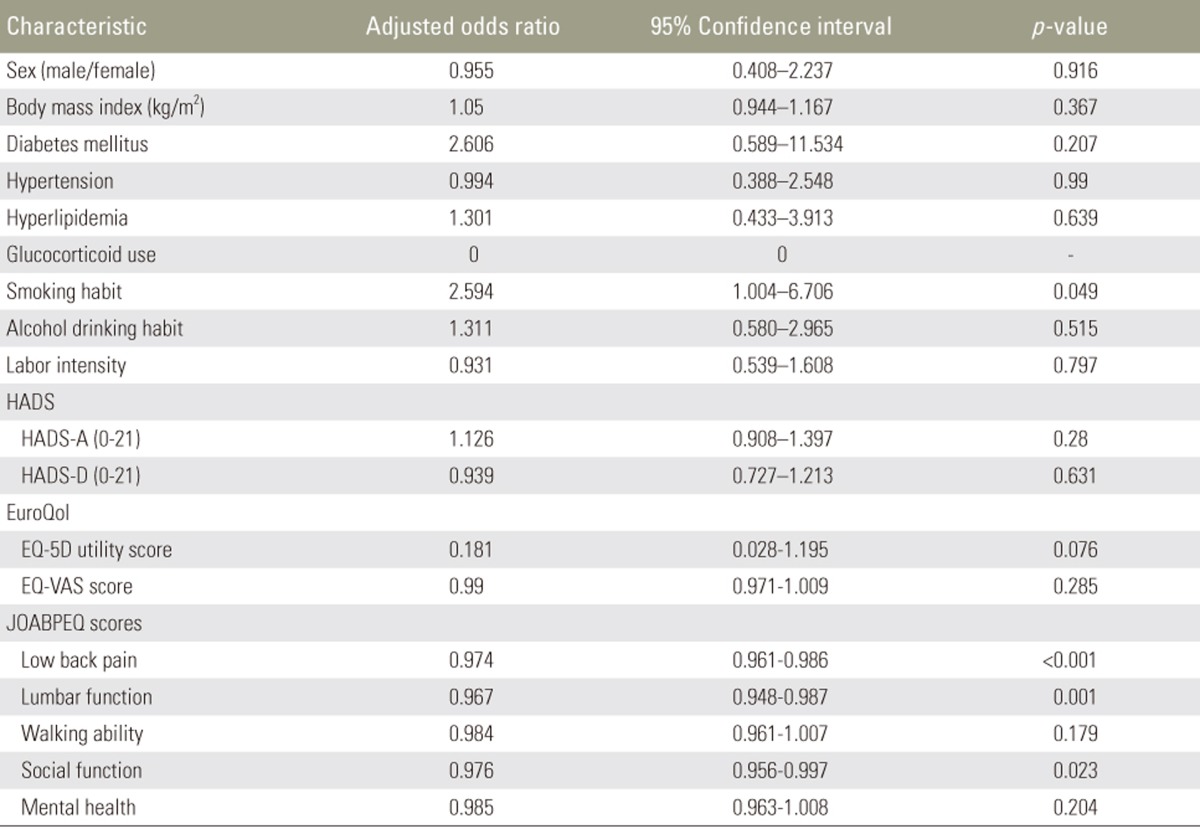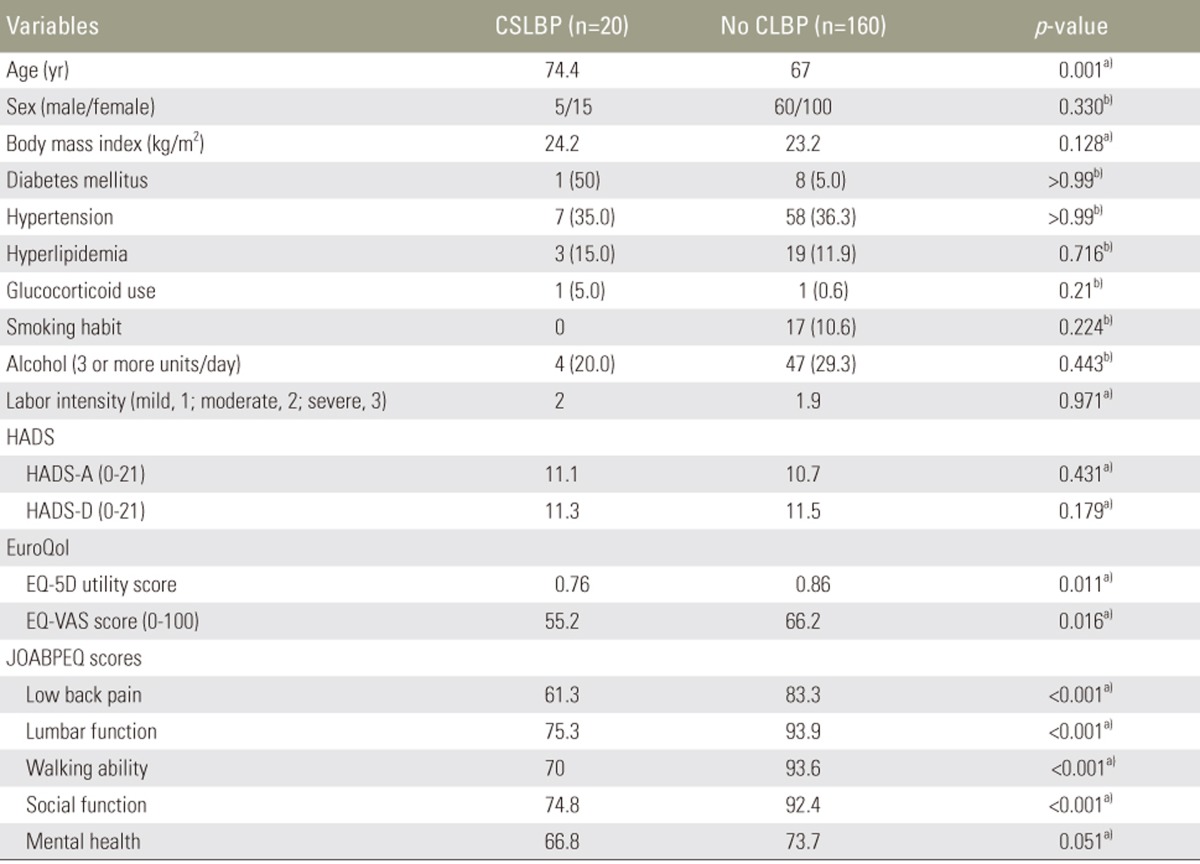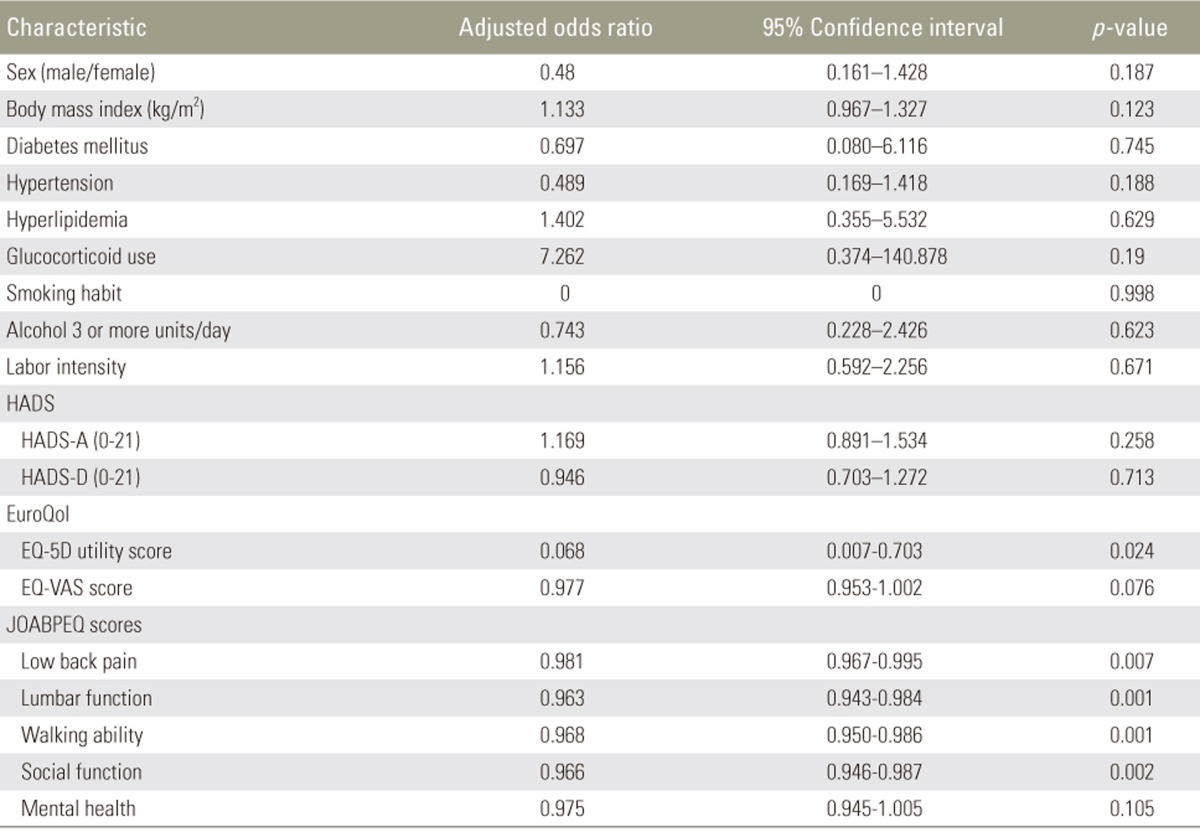1. Chou R, Qaseem A, Snow V, et al. Diagnosis and treatment of low back pain: a joint clinical practice guideline from the American College of Physicians and the American Pain Society. Ann Intern Med 2007 147:478–491. PMID:
17909209.


2. Yoshimura N, Akune T, Fujiwara S, et al. Prevalence of knee pain, lumbar pain and its coexistence in Japanese men and women: The Longitudinal Cohorts of Motor System Organ (LOCOMO) study. J Bone Miner Metab 2014 32:524–532. PMID:
24213218.


3. Hirano K, Imagama S, Hasegawa Y, Ito Z, Muramoto A, Ishiguro N. Impact of low back pain, knee pain, and timed up-and-go test on quality of life in community-living people. J Orthop Sci 2014 19:164–171. PMID:
24132792.


4. Muraki S, Akune T, Oka H, et al. Health-related quality of life in subjects with low back pain and knee pain in a population-based cohort study of Japanese men: the Research on Osteoarthritis Against Disability study. Spine (Phila Pa 1976) 2011 36:1312–1319. PMID:
21730819.


5. Nakamura M, Nishiwaki Y, Ushida T, Toyama Y. Prevalence and characteristics of chronic musculoskeletal pain in Japan. J Orthop Sci 2011 16:424–432. PMID:
21678085.



6. Deyo RA. Diagnostic evaluation of LBP: reaching a specific diagnosis is often impossible. Arch Intern Med 2002 162:1444–1447. PMID:
12090877.


7. Airaksinen O, Brox JI, Cedraschi C, et al. Chapter 4. European guidelines for the management of chronic nonspecific low back pain. Eur Spine J 2006 15(Suppl 2): S192–S300. PMID:
16550448.



8. Japanese Orthopaedic Association. Clinical practice guideline for the management of low back pain. Tokyo: Nankodo Co; 2012.
9. Hartvigsen J, Bakketeig LS, Leboeuf-Yde C, Engberg M, Lauritzen T. The association between physical workload and low back pain clouded by the “healthy worker” effect: population-based cross-sectional and 5-year prospective questionnaire study. Spine (Phila Pa 1976) 2001 26:1788–1792. PMID:
11493851.


10. Grotle M, Vollestad NK, Brox JI. Clinical course and impact of fear-avoidance beliefs in low back pain: prospective cohort study of acute and chronic low back pain: II. Spine (Phila Pa 1976) 2006 31:1038–1046. PMID:
16641782.


11. Hartvigsen J, Frederiksen H, Christensen K. Physical and mental function and incident low back pain in seniors: a population-based two-year prospective study of 1387 Danish Twins aged 70 to 100 years. Spine (Phila Pa 1976) 2006 31:1628–1632. PMID:
16778700.


12. Kopec JA, Sayre EC, Esdaile JM. Predictors of back pain in a general population cohort. Spine (Phila Pa 1976) 2004 29:70–77. PMID:
14699279.


13. Meyer T, Cooper J, Raspe H. Disabling low back pain and depressive symptoms in the community-dwelling elderly: a prospective study. Spine (Phila Pa 1976) 2007 32:2380–2386. PMID:
17906583.


14. Goldberg MS, Scott SC, Mayo NE. A review of the association between cigarette smoking and the development of nonspecific back pain and related outcomes. Spine (Phila Pa 1976) 2000 25:995–1014. PMID:
10767814.


15. Leboeuf-Yde C. Smoking and low back pain: a systematic literature review of 41 journal articles reporting 47 epidemiologic studies. Spine (Phila Pa 1976) 1999 24:1463–1470. PMID:
10423792.


16. Shiri R, Karppinen J, Leino-Arjas P, Solovieva S, Viikari-Juntura E. The association between smoking and low back pain: a meta-analysis. Am J Med 2010 123:8787.e7–87.e35.


17. Konno S, Hayashino Y, Fukuhara S, et al. Development of a clinical diagnosis support tool to identify patients with lumbar spinal stenosis. Eur Spine J 2007 16:1951–1957. PMID:
17549525.



18. Nikaido T, Sekiguchi M, Yonemoto K, et al. Can be ABI in the lumbar spinal stenosis diagnosis support tool substituted by palpation of posterior tibial artery? - a multicenter crosssectional study (DISTO-PROJECT): GP86. Spine 2014 (Supp 1): 159.
19. EuroQol Group. EuroQol: a new facility for the measurement of health-related quality of life. Health Policy 1990 16:199–208. PMID:
10109801.


20. on behalf of the Japanese EuroQol Tariff Project. Ikeda S, Ikegemi N. Health status in Japanese population: results from Japanese EuroQol Study. J Health Care Soc 1999 9:83–92.

21. Fukui M, Chiba K, Kawakami M, et al. JOA back pain evaluation questionnaire: initial report. J Orthop Sci 2007 12:443–450. PMID:
17909929.



22. Schwab F, Ungar B, Blondel B, et al. Scoliosis Research Society-Schwab adult spinal deformity classification: a validation study. Spine (Phila Pa 1976) 2012 37:1077–1082. PMID:
22045006.


23. Walker BF. The prevalence of low back pain: a systematic review of the literature from 1966 to 1998. J Spinal Disord 2000 13:205–217. PMID:
10872758.


24. Bressler HB, Keyes WJ, Rochon PA, Badley E. The prevalence of low back pain in the elderly: a systematic review of the literature. Spine (Phila Pa 1976) 1999 24:1813–1819. PMID:
10488512.


25. Wai EK, Rodriguez S, Dagenais S, Hall H. Evidence-informed management of chronic low back pain with physical activity, smoking cessation, and weight loss. Spine J 2008 8:195–202. PMID:
18164467.


26. Iwahashi M, Matsuzaki H, Tokuhashi Y, Wakabayashi K, Uematsu Y. Mechanism of intervertebral disc degeneration caused by nicotine in rabbits to explicate intervertebral disc disorders caused by smoking. Spine (Phila Pa 1976) 2002 27:1396–1401. PMID:
12131735.


27. Akmal M, Kesani A, Anand B, Singh A, Wiseman M, Goodship A. Effect of nicotine on spinal disc cells: a cellular mechanism for disc degeneration. Spine (Phila Pa 1976) 2004 29:568–575. PMID:
15129075.


28. Uei H, Matsuzaki H, Oda H, Nakajima S, Tokuhashi Y, Esumi M. Gene expression changes in an early stage of intervertebral disc degeneration induced by passive cigarette smoking. Spine (Phila Pa 1976) 2006 31:510–514. PMID:
16508543.


29. Nemoto Y, Matsuzaki H, Tokuhasi Y, et al. Histological changes in intervertebral discs after smoking and cessation: experimental study using a rat passive smoking model. J Orthop Sci 2006 11:191–197. PMID:
16568393.


30. Ishimoto Y, Yoshimura N, Muraki S, et al. Associations between radiographic lumbar spinal stenosis and clinical symptoms in the general population: the Wakayama Spine Study. Osteoarthritis Cartilage 2013 21:783–788. PMID:
23473979.




